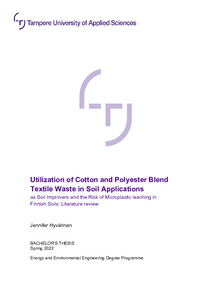Utilization of cotton and polyester blend textile waste in soil applications
Hyvärinen, Jennifer (2022)
Hyvärinen, Jennifer
2022
Julkaisun pysyvä osoite on
https://urn.fi/URN:NBN:fi:amk-2022052512081
https://urn.fi/URN:NBN:fi:amk-2022052512081
Tiivistelmä
With increasing amounts of textile waste, its inefficient disposal, and the complexity of textile composition, the concern for environmental impacts from textile waste have risen. Cotton and polyester blend textile waste are more challenging to recycle than non-blended textile waste, due to the bonding of fibers. This thesis aims to find alternative paths for textile waste to increase circularity. In collaboration with a Finnish sustainable fashion company, GlobeHope, the utilization of cotton and polyester blend textile waste in Finnish soil was investigated through a literature review.
This thesis project looked into three different methods allowing utilization of cotton and polyester blend textile waste in soils: separated fiber for soil enhancement, plastic mulching alternative, and geotextiles applications. Challenges of textile waste were studied and was found that microplastic and chemical contamination risks exist due to substances such as microfibers and dye dust that may be present in textiles. Factors affecting the degradation of polyester causing the leaching of microplastics were investigated to study whether cotton and polyester blend textile waste can be incorporated into soils in Finland.
It was concluded that the most suitable options for using cotton and polyester blend textile waste are geotextile and agriculture utilization, such as erosion prevention and plastic mulching alternatives. However, further studies and experiments must be done to further understand the interaction between textile waste and soil, to safely be used in soils.
This thesis project looked into three different methods allowing utilization of cotton and polyester blend textile waste in soils: separated fiber for soil enhancement, plastic mulching alternative, and geotextiles applications. Challenges of textile waste were studied and was found that microplastic and chemical contamination risks exist due to substances such as microfibers and dye dust that may be present in textiles. Factors affecting the degradation of polyester causing the leaching of microplastics were investigated to study whether cotton and polyester blend textile waste can be incorporated into soils in Finland.
It was concluded that the most suitable options for using cotton and polyester blend textile waste are geotextile and agriculture utilization, such as erosion prevention and plastic mulching alternatives. However, further studies and experiments must be done to further understand the interaction between textile waste and soil, to safely be used in soils.
